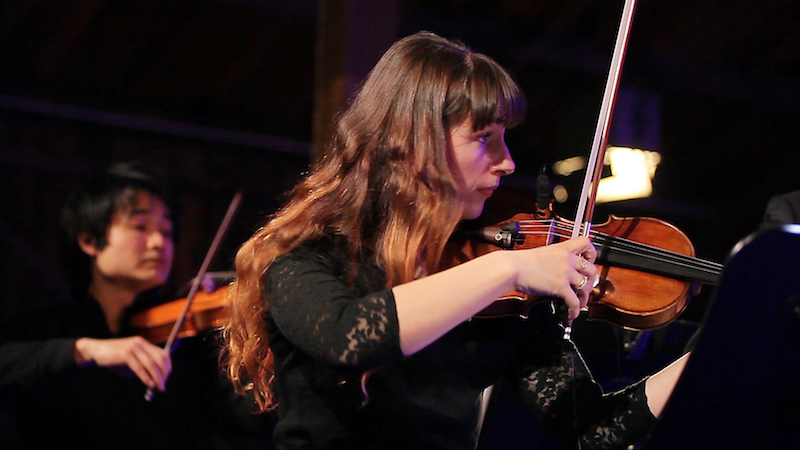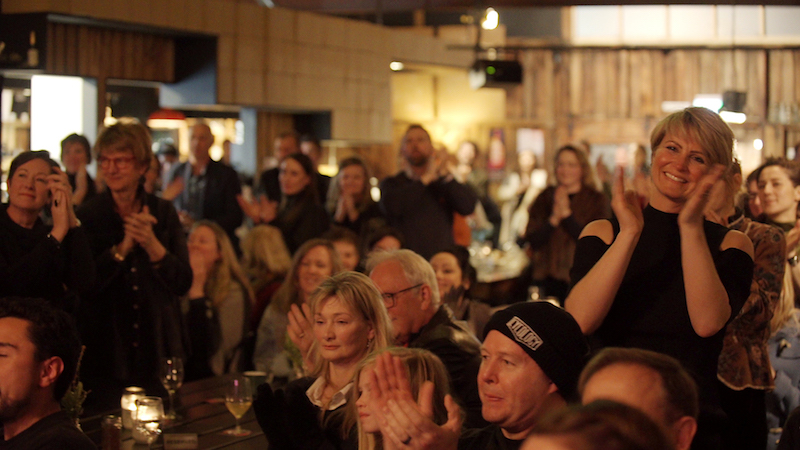Donning a woolly scarf and ear muffs, I braced for the frosty night, picked up a friend, and drove into moonlit Tasmanian countryside. It took a little more than half an hour to reach our venue – Willie Smith’s Apple Shed – where intimate groups of friends and music lovers had congregated for a live performance by musicians of the Tasmanian Symphony Orchestra.
With a fresh plate of seafood, a hot mulled cider, and, of course, a slice of house made apple pie, I made my way into the packed-out space to take a seat at a communal, candlelit table. People – new friends – I’d never met sat across from me, buzzing with a liveliness that engulfed the shed. To one side, a wall-sized shelf displayed many varieties of apples (being located in our well-known ‘Apple Isle’) and, at the front, a stage was set up with a blue backlight.
 Emma McGrath at TSO Live Sessions. Photo © Richard Jupe
Emma McGrath at TSO Live Sessions. Photo © Richard Jupe
This was the first TSO Live Sessions concert to take place in this venue, as concertmaster Emma McGrath told the audience, following the Hobart Brewing Company’s Live Sessions event earlier this year. Chatting to the crowd, McGrath likened these pub atmospheres to a wildlife sanctuary for her group of orchestral musicians: out of the comfort zone.
The concert opened with Corelli’s six-movement Christmas Concerto – a little late even for Christmas in July, but a beautiful work nevertheless, although it must be said that rousing a cider-warmed crowd with banter, and then launching straight into a slow movement, was a little off-putting. It made the opening seem too lethargic for the occasion, but it soon made way for a speedier Allegro and we were back on track.
The woody textures of the TSO strings were offset visually by the timber structure of this apple shed. Though this felt organic, the instruments were amplified to suit the contemporary ethos of the night, and likely to rise above anticipated chatter in the audience. The baroque sensitivities were lost to this, while occasionally out-of-sync entries and tuning were intensified where they may ordinarily have been hidden under sheer lack of volume. But these are minor quibbles and not a significant cost to the evening.
It took four movements out of six for the audience to finally clap between them, which further enabled us to relax. This Corelli was a rigid selection for the atmosphere, even within the realm of highly structured baroque music. And when the different string instruments were exposed within their sections, there simply wasn’t enough presence to rival a crowd of such size and energy. But the musicians’ easy-going attitudes – coupled with it becoming socially acceptable to eat and talk through the music – meant it didn’t stay tame for long. And, really, the work was a stunner anyway.
After a substantial break, the party seemed to truly kick off when we heard Astor Piazzolla’s Four Seasons of Buenos Aires. Wow, in a word! The first movement was Summer, which featured solo violinist Edwina George in the centre of a half-ring of musicians. Each of the four movements represented a season, and referred loosely to Vivaldi’s Four Seasons – a suitable choice to reflect on the baroque elements earlier in the evening. But the sleazy tango beat was unmistakably Piazzolla and had the audience entranced with a silence that would have been appropriate for the concert hall.
 The audience in Willie Smith’s Apple Shed for TSO Live Sessions. Photo © Richard Jupe
The audience in Willie Smith’s Apple Shed for TSO Live Sessions. Photo © Richard Jupe
The second movement, Autumn, showcased Hayato Simpson. If the intention in choosing different soloists for each movement was to show off the diversity within the TSO’s violin section, this was a success. Simpson’s approach was perhaps the most contrasting within the group, with a lighter and more romantic touch – that is, until the brutally abrupt finale of this movement.
Winter came with Miranda Carson, who was thoroughly seductive. Her movement was aurally the fullest, and her unleashed and reverberant performance seemed to transcend all that came before. Carson took us through passion and sentimentality alike – and all the while dressed in a frayed denim skirt beneath her concert black shirt; proving that breaking stiff dress codes makes very little difference to a performer’s ability to play, and an audience’s ability to enjoy. In the final movement of the Piazzolla, Lucy Carrig Jones presented Spring, which as the piece progressed became almost too intense for the cider house setting – or maybe it was just me becoming too enthralled – concluding a thoroughly energising performance, which garnered a standing ovation.
For the encore, the ensemble played Leroy Anderson’s Plink, Plank, Plunk – sending us home with what McGrath deemed a “plucking good time”: adorable comic relief to end an otherwise heavy evening: heavy with fulfilling music, heavy with warm conversation, and heavy with far too much apple pie. A resounding success.











Comments
Log in to join the conversation.